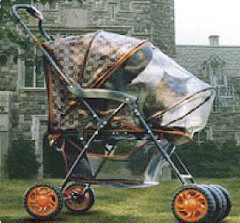A Groomer's Tip To Effective Pet Handling Through Understanding Pack Mentality
NATURAL INSTINCTS
A dog's natural instinct plays a vital role in pet handling. It is often difficult to differentiate between instinct and intelligence. Instinct is an urge from within. Instinct makes a dog act in certain ways and has no connection with intelligence.
A common misperception is that the expectations we have for dogs are far above their ability. Some people believe dogs understand complex thought patterns and are able to comprehend our moral and ethical codes. They assume a dog's level of understanding is the same as our own. There is a scientific name for this, Anthropomorphism. Anthropomorphism means: “to assign emotion or thought patterns to animals or objects, which are incapable of achieving such dimensions.”
This is not the case. Dogs work on drive levels and instinct. It is important while handling a dog to keep in mind that they do not have the capacity to comprehend the complex thought processes that bring us to understand human emotions, language and behavior.
Most instincts provide pleasure to the dog, and because it associates the action with pleasure, learning to use the natural instinct for handling purposes will produce a positive result.
The first is an instinct that is reinforced when the dog is a puppy. Female dogs carry their young by gently picking them up by the back of the neck. The puppy instinctually stops playing and/or wiggling when it is in this position. Using this knowledge and simulating the same pressure that a mother exerts in controlling her puppies will assist in handling the dog. It is important to remember this fact; the natural response of a mother or leader dog is to release the restraint or grasp as soon as the dog submits. Therefore, restrain when needed.
The second instinct is how a subordinate dog will be ‘muzzled' by another dog. This puts that dog into a submissive state. You can illicit that same state by simulating the same behavior on that dog.
PACK MENTALITY
To understand a dog's behavior, you must first understand that a dog is a pack animal. This Pack Mentality means that in a dog's mind you are either a leader or a follower – depending on your actions. In a dog's world, this is the natural order of life – each dog has his place in the pack.
Pack Mentality focuses on behaving as the leader commands. Dogs (Canis lupus familiaris) are wolves (Canis lupus) of many colors, shapes, and sizes. Wolves live by a very strict code of behavior, which is based on pack hierarchy. The Leader in any dog or wolf pack is considered the Alpha. The Alpha protects the pack, shelters the pack, feeds the pack, and determines how the pack reacts and behaves.
Dominance, Submission, and Aggression
The goal is to have the dog see you, the groomer, as the Alpha, which will allow you to use that authority to guide the dog – even though you cannot communicate with him on his own level. Therefore, understanding dominance, submission, aggression, and the dog's affinity for group living are important to effective safe pet handling
Dominance, submission, and aggression are complex behaviors between dogs. When you add in the human factor these complex behaviors are compounded. Dogs behave differently with humans than they do with other dogs. This is an important fact that must be considered every time a dog is brought into your grooming shop or van.
The Many Sides Of Dog Behavior
Understand this – a dog's behavior is never 100 % predictable.
A dog can be submissive to people and also be dominant to other dogs.
A dog can be submissive to adults and be dominant to children.
A dog in the middle may quarrel with other dogs (or not) and vacillate between tough guy and wimp in relationships with people.
A dog may behave in a dominant fashion on one day and be submissive the next.
A dog will willingly obey one groomer and completely ignore another groomer.
Bottom Line: A dog that is allowed to dominate humans can become a menace to groomers. Learn about the Leading Behavior Modification Equipement at Groomers Helper®.
Groomers Taking Control – Understanding Pack Mentality and Using it
When a dog arrives at a grooming shop its natural instinct is to immediately establish his place in the pack. Some dogs assume an automatic submissive role and will automatically act like a subordinate. Others will be more aggressive, and exhibit pushy behavior, attempting to climb the social ladder as high as you will allow them to.
Authority is established through being firm, but fair. A dog that growls, shows his teeth or nips at lower pack members loses respect from the other pack members. Alpha dogs that display aggression are often challenged, as they are considered a threat to other pack members. Being aggressive does not earn respect.
Confidence is at the top of the list. Observing body language is pertinent to surviving in a pack. A dominant dog is confident, stands tall, ears forward, and maintains eye contact. Dogs are known for their intuition, and this is derived from a pack instinct. The dog will watch you for eye contact and confidence, and this is important in maintaining an Alpha position in the grooming shop. Remember a dog's behavior is based on natural instincts derived from the Pack Mentality.
A lower ranked dog will not challenge a higher rank for food, or act aggressively towards a dog that is higher in the social structure of the pack. If a dog growls when you go to pick him up or put a leash on him, he is exhibiting a sign that he does not feel you have a higher ranking in the pack. An Alpha male will not accept commands from lower ranking dogs.

































.jpg)








